William Hole
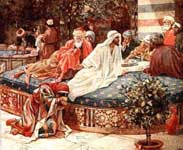
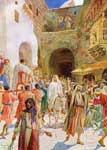
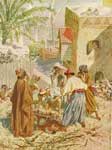
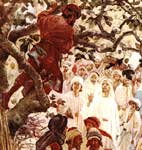
Zacchaeus being called down from the tree
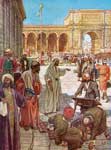
Jesus Casts Out The Money Changers
William Brassey Hole RSA (7 November 1846 – 22 October 1917) was an English artist, illustrator, etcher and engraver, known for his industrial, historical and biblical scenes.
Life
Early life and training
Hole was born in Salisbury, Wiltshire, the son of a doctor, Richard Hole and his wife Ann; His father died in the cholera epidemic of 1849, when William was only 3 years of age, and the family relocated to Edinburgh, Scotland, shortly afterwards. He was educated at Edinburgh Academy, then served an apprenticeship as a civil engineer for 5 years, although he really wanted to be an artist.[1]
In 1869, he sailed from Swansea to Genoa, and spent the next 6 months travelling and sketching around Italy. In Rome he made the acquaintance of Keeley Halswelle who gave him practical advice on art. It was Halwelle whose criticism encouraged Hole to endeavour to become a professional painter.[1]
On returning to Edinburgh, Hole entered the School of Design, then won admission to the life school of the Royal Scottish Academy, first exhibiting there in 1873; in 1878 he was elected an associate of the Academy. Around this time he took up etching and was accepted into the Royal Society of Painters and Etchers (RE) in 1885; he was already a member of the Royal Scottish Watercolour Society (RSW) from 1884. He eventually became a full member of the Academy (RSA).[1]
Career
Illustration from "A window in Thrums" (by J M Barrie)
The grave of William Hole RSA, Grange Cemetery, Edinburgh
Hole went on to specialise in painting industrial and historical material. Although an Englishman by birth, he devoted much of his energies to Scottish national subjects and purposes.
Principal paintings include "End of the '45" (1879), "A Straggler of the Chevalier's Army", " Culloden", "Prince Charlie's Parliament" (1882), "If thou hadst known" (1885) and "The Canterbury Pilgrims" (1889). Other paintings included "Medea in the Island of Circe", several based on Arthurian legend, and several depicting the life of fishermen on the west coast of Scotland, exhibited in 1883-84. Of the latter, "The Night's Catch" and "The fill of the two Boats" were praised by critics.[2]
Hole's etchings were also highly regarded, one critic describing them as "perhaps the most wonderful translations of colour and handling, of design and conception and spirit, into another artistic medium ever made, and entitle their author to rank with creative artists of the highest class".[2]
Around 1900, he travelled to Palestine in order to study the background for biblical painting. There he began working on the 80 watercolours that would eventually appear as illustrations in his book "The Life of Jesus of Nazareth."[3] In April to May 1906 these pictures were shown at an exhibition at the Fine Art Society in London.[4] He also painted scenes from the Old Testament.
In 1898 Hole painted a Processional Frieze for the entrance hall of the Scottish National Portrait Gallery, showing over 150 figures or "heroes" from Scotland’s past. A critic described this work as "one of the most notable essays in mural decoration ever accomplished in this country". He also provided historical paintings for Edinburgh City Chambers and ecclesiastical decorations for other buildings.[2]
Hole drew the black and white illustrations for several books including works by Robert Louis Stevenson, J M Barrie, and Robert Burns.
In later life he lived at 13 Inverleith Terrace in north Edinburgh, his neighbour at 15 being fellow-artist James Cadenhead.[5]
Hole died in Edinburgh in 1917. He is buried in the Grange Cemetery in the ground of James Lindsay in the centre of the north wall. His name is listed at the base of the monument along with other members of the Hole family.
Notes
Meynell, 1887.
Caw, p. 268 ff.
"W B Hole's "Life of Jesus Christ"". Bibleillustration.blogspot.com. 2008-05-26. Retrieved 2012-05-14.
"Exhibition at the Fine Arts Society, 1906". Exhibitionculture.arts.gla.ac.uk. 1906-08-01. Retrieved 2012-05-14.
Edinburgh and Leith Post Office Directory 1911-12
Bibliography
Illustrated by Hole (not complete)
Hole, William. Quasi cursores (Edinburgh Univ. Press, 1884).
Stevenson, R. L. The Wrecker (Charles Scribner's Sons, New York, 1892).
Stevenson, R. L. Catriona (London: Cassell, 1893).
MacLaren, Ian. Beside The Bonnie Brier Bush (Hodder & Stoughton, 1896).
Barrie, J. M. Auld Licht Idylls (Hodder & Stoughton, 1902).
Barrie, J. M. A Window in Thrums (London: Hodder and Stoughton, 1902).
Hole, William. The life of Jesus of Nazareth: eighty pictures (Eyre & Spottiswoode, 1906).
Hole William. The Holy Bible. Containing The Old And New Testaments (Eyre & Spottiswoode, 1925).
About Hole
Winifred Meynell. The modern school of art, Volume 4 (W. R. Howell, c. 1887).
Caw, James L. Scottish painting past and present (T.C. & E.C. Jack, 1908).
Ackerman, Gerald M. Les orientalistes de l'Ecole Britannique (Art Creation Realisation, 1991) p. 323.
----
Fine Art Prints | Greeting Cards | Phone Cases | Lifestyle | Face Masks | Men's , Women' Apparel | Home Decor | jigsaw puzzles | Notebooks | Tapestries | ...
----
Artist
A - B - C - D - E - F - G - H - I - J - K - L - M -
N - O - P - Q - R - S - T - U - V - W - X - Y - Z
Retrieved from "http://en.wikipedia.org/"
All text is available under the terms of the GNU Free Documentation License


